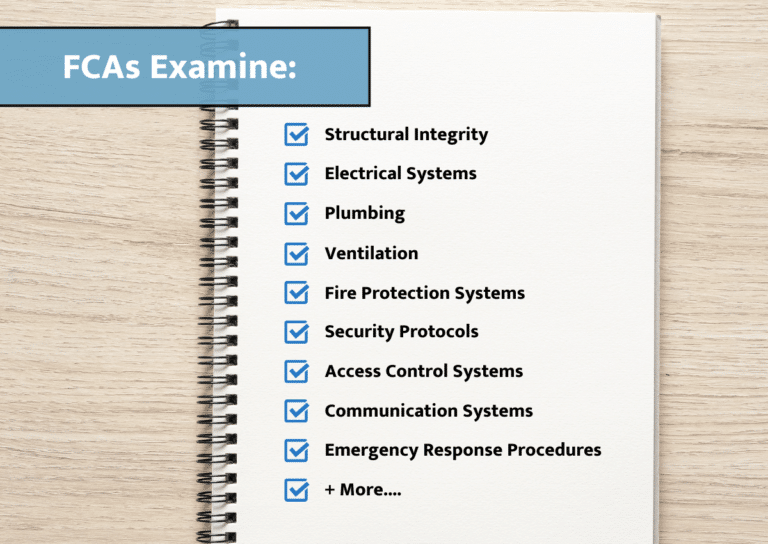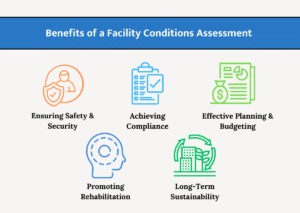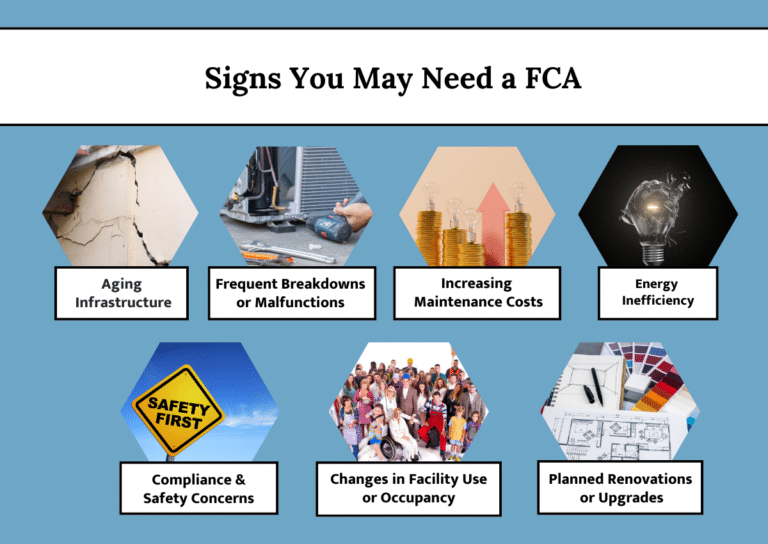
Enhancing Criminal Justice Facilities: The Power of Facility Conditions Assessments
Criminal justice facilities, such as detention and correctional centers, play a critical role in maintaining public safety and facilitating the rehabilitation of inmates. To fulfill these responsibilities effectively, facility owners must ensure that their establishments meet the highest standards of safety, functionality, and compliance. Without proper funding, the cost of deferred maintenance will double every five years. Read our “Deferred Maintenance Crisis Whitepaper” for examples. This is where Facility Conditions Assessments come into play.
 In this blog post, we will explore what constitutes a Facility Conditions Assessments and the benefits they offer to owners in enhancing their criminal justice facilities.
In this blog post, we will explore what constitutes a Facility Conditions Assessments and the benefits they offer to owners in enhancing their criminal justice facilities.
What is a Facility Conditions Assessment?
A Facility Conditions Assessment is a comprehensive evaluation of a criminal justice facility’s physical infrastructure and operational aspects. This assessment aims to identify safety hazards, assess functionality, and determine compliance with applicable laws, regulations, and standards. It involves a meticulous examination of critical components, including:
- structural integrity
- electrical systems
- plumbing
- ventilation
- fire protection systems
- security protocols
- access control systems
- communication systems
- emergency response procedures
- and more…
Signs You May Need a FCA
There are several signs that may indicate the need for a Facility Conditions Assessment. Here are a few indicators to consider:
- Aging infrastructure: If your facility is older and has not undergone a comprehensive assessment in recent years, it may be a good time to evaluate the condition of various systems and components.
- Frequent breakdowns or malfunctions: If you’re experiencing frequent equipment failures, system malfunctions, or breakdowns, it could be an indication of underlying issues that need to be addressed.
- Increasing maintenance costs: If you notice a steady rise in maintenance and repair costs, it could be a sign that your facility’s infrastructure is deteriorating or that there are inefficiencies in its systems.
- Energy inefficiency: Higher energy bills or poor energy performance can suggest that your facility’s systems, such as HVAC, lighting, or insulation, may need attention to improve efficiency and reduce costs.
- Compliance and safety concerns: If you have concerns about meeting regulatory compliance requirements or if there are safety issues within your facility, a facility condition assessment can help identify areas that need improvement.
- Changes in facility use or occupancy: If your facility has undergone changes in its use, such as new equipment installations, expansions, or increased occupancy, it’s important to assess the impact on the overall condition and functionality of the facility.
- Planning for renovations or upgrades: If you’re considering renovations or upgrades to your facility, a condition assessment can provide valuable insights to inform your decision-making process and help prioritize investments.
By conducting a facility condition assessment, you can gain a comprehensive understanding of the current state of your facility, identify areas of concern, and develop a strategic plan for maintenance, repairs, and improvements.
Benefits of Facility Conditions Assessment
- Ensuring Safety and Security: Facility Conditions Assessments enable owners to identify potential safety hazards or deficiencies within their facilities. By evaluating the physical infrastructure and critical components such as electrical systems, plumbing, ventilation, and fire protection, owners can address issues proactively. This ensures a safer environment for both staff and inmates, reducing the risk of accidents, injuries, or security breaches.
- Achieving Compliance: Compliance with laws, regulations, and standards is essential for criminal justice facility owners. Facility Conditions Assessments help owners identify areas of non-compliance, such as building codes, fire safety regulations, health and sanitation standards, and accessibility guidelines. By rectifying these issues, owners can maintain compliance, avoid penalties, and create a lawful environment conducive to effective operations.
- Effective Planning and Budgeting: By conducting Facility Conditions Assessments, facility owners gain insights into the maintenance and repair needs of their establishments. These assessments provide a clear understanding of infrastructure condition, equipment functionality, and systems performance. Owners can then prioritize and plan for necessary repairs, replacements, or upgrades. Proactive planning prevents future deterioration, reduces the risk of costly emergency repairs, and allows for efficient resource allocation.
- Promoting Rehabilitation: A well-maintained and secure facility is vital for inmate rehabilitation. Facility Conditions Assessments help owners identify areas where improvements are needed, such as security protocols, access control systems, and communication systems. By addressing these aspects, owners contribute to creating an environment conducive to inmate rehabilitation. A safe and supportive environment enhances the chances of successful reintegration into society.
- Long-Term Sustainability: Facility Conditions Assessments assist owners in long-term planning and sustainability. By evaluating the condition of infrastructure, equipment, and systems, owners can estimate lifecycle costs and plan for future renovations or expansions. These assessments provide the necessary information to make informed decisions about investments and budgeting, ensuring the facility’s long-term viability.
Well Worth the Effort
Facility Conditions Assessments may require considerable resources, but they are key to making informed decisions and achieving your desired outcomes. When done properly, Facility Conditions Assessments are a powerful tool for criminal justice facility owners to enhance their establishments. By gaining an in-depth understanding of the conditions faced by the workers and the living conditions of the incarcerated population, justice leaders are empowered to make informed decisions, allocate resources wisely, engage in strategic long term capital planning, and develop capital repairs and upgrades to the facility that make an impact. Through these efforts, detention and correctional facilities can become transformative spaces that foster growth, reduce recidivism, and promote the successful reintegration of individuals into society.
Want to Learn More?
This is the second post in a three-part series aimed towards educating our readers on the benefits of Needs Assessments and Facility Conditions Assessments. Part One, was a recent blog post by Chloe Jaco titled, “Demystifying Needs Assessments: 7 Questions to Guide Justice Leaders in Defining and Implementing Effective Assessments”. Part Two is this blog post discussing the power of Facility Conditions Assessments. Part Three, the final post in the series will be discussing the differences between Facility Conditions Assessments and Needs Assessments with an aim at helping readers understand which one best applies to their needs at hand.






